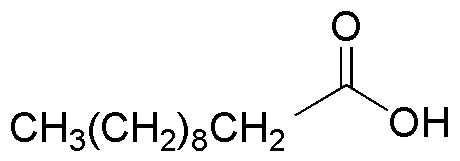Undecanoic acid is widely utilized in research focused on various applications:
- Biotechnology: It serves as a fatty acid building block for synthesizing biodiesel, providing a renewable energy source that is more environmentally friendly compared to fossil fuels.
- Food Industry: Used as a flavoring agent and preservative, it helps enhance the taste and shelf life of certain food products, making them more appealing to consumers.
- Pharmaceuticals: This compound is employed in drug formulation as an excipient, improving the solubility and bioavailability of active ingredients in medications.
- Cosmetics: Undecanoic acid is included in skin care products for its emollient properties, helping to moisturize and soften the skin while providing a natural alternative to synthetic additives.
- Polymer Industry: It acts as a monomer in the production of polyamides and polyesters, contributing to materials that are durable and resistant to heat, ideal for various industrial applications.
General Information
Properties
Safety and Regulations
Applications
Undecanoic acid is widely utilized in research focused on various applications:
- Biotechnology: It serves as a fatty acid building block for synthesizing biodiesel, providing a renewable energy source that is more environmentally friendly compared to fossil fuels.
- Food Industry: Used as a flavoring agent and preservative, it helps enhance the taste and shelf life of certain food products, making them more appealing to consumers.
- Pharmaceuticals: This compound is employed in drug formulation as an excipient, improving the solubility and bioavailability of active ingredients in medications.
- Cosmetics: Undecanoic acid is included in skin care products for its emollient properties, helping to moisturize and soften the skin while providing a natural alternative to synthetic additives.
- Polymer Industry: It acts as a monomer in the production of polyamides and polyesters, contributing to materials that are durable and resistant to heat, ideal for various industrial applications.
Documents
Safety Data Sheets (SDS)
The SDS provides comprehensive safety information on handling, storage, and disposal of the product.
Product Specification (PS)
The PS provides a comprehensive breakdown of the product’s properties, including chemical composition, physical state, purity, and storage requirements. It also details acceptable quality ranges and the product's intended applications.
Certificates of Analysis (COA)
Search for Certificates of Analysis (COA) by entering the products Lot Number. Lot and Batch Numbers can be found on a product’s label following the words ‘Lot’ or ‘Batch’.
*Catalog Number
*Lot Number
Certificates Of Origin (COO)
This COO confirms the country where the product was manufactured, and also details the materials and components used in it and whether it is derived from natural, synthetic, or other specific sources. This certificate may be required for customs, trade, and regulatory compliance.
*Catalog Number
*Lot Number
Safety Data Sheets (SDS)
The SDS provides comprehensive safety information on handling, storage, and disposal of the product.
DownloadProduct Specification (PS)
The PS provides a comprehensive breakdown of the product’s properties, including chemical composition, physical state, purity, and storage requirements. It also details acceptable quality ranges and the product's intended applications.
DownloadCertificates of Analysis (COA)
Search for Certificates of Analysis (COA) by entering the products Lot Number. Lot and Batch Numbers can be found on a product’s label following the words ‘Lot’ or ‘Batch’.
*Catalog Number
*Lot Number
Certificates Of Origin (COO)
This COO confirms the country where the product was manufactured, and also details the materials and components used in it and whether it is derived from natural, synthetic, or other specific sources. This certificate may be required for customs, trade, and regulatory compliance.

